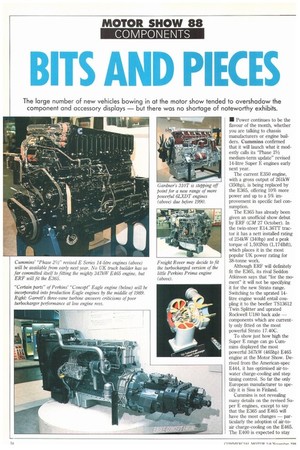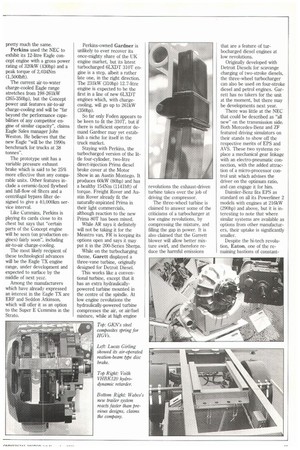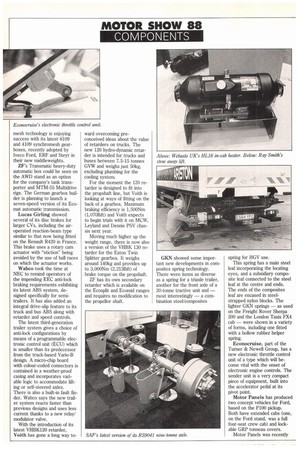BITS AND PIECES
Page 44

Page 45

Page 46

Page 47

If you've noticed an error in this article please click here to report it so we can fix it.
The large number of new vehicles bowing in at the motor show tended to overshadow the component and accessory displays — but there was no shortage of noteworthy exhibits.
• Power continues to be the flavour of the month, whether you are talking to chassis manufacturers or engine builders. Cummins confirmed that it will launch what it modestly calls its "Phase 21/2 medium-term update" revised 14-litre Super E engines early next year.
The current E350 engine, with a gross output of 261kW (350hp), is being replaced by the E365, offering 10% more power and up to a 5% improvement in specific fuel consumption.
The E365 has already been given an unofficial show debut by ERF (CM 27 October). In the twin-steer E14.36TT tractor it has a nett installed rating of 254kW (340hp) and a peak torque of 1,593Nm (1,1741bft), which places it in the most popular UK power rating for 38-tonne work.
Although ERF will definitely fit the E365, its rival Seddon Atkinson says that "for the moment" it will not be specifying it for the new Strato range. Switching to the uprated 14litre engine would entail coupling it to the beefier TS13612 Twin Splitter and uprated Rockwell U180 back axle — components which are currently only fitted on the most powerful Strato 17.40C.
To show just how high the Super E range can go Cummins displayed the most powerful 347kW (465hp) E465 engine at the Motor Show. Derived from the American-spec E444, it has optimised air-towater charge-cooling and step timing control. So far the only European manufacturer to specify it is Sisu in Finland.
Cummins is not revealing many details on the revised Super E engines, except to say that the E365 and E465 will have the most changes — particularly the adoption of air-toair charge-cooling on the E465. The E400 is expected to stay pretty much the same.
Perkins used the NEC to exhibit its 12-litre Eagle concept engine with a gross power rating of 320kW (430hp) and a peak torque of 2,034Nm (1,5001bft).
The current air-to-water charge-cooled Eagle range stretches from 198-261kW (265-350hp), but the Concept power unit features air-to-air charge-cooling and will be "far beyond the performance capabilities of any competitor engine of similar capacity", claims Eagle Sales manager John Weston. He believes that the new Eagle "will be the 1990s benchmark for trucks at 38 tonnes".
The prototype unit has a variable pressure exhaust brake which is said to be 25% more effective than any comparable units. Other features inchide a ceramic-faced flywheel and full-flow oil filters and a centrifugal bypass filter designed to give a 40,000km service interval.
Like Cummins, Perkins is playing its cards close to its chest but says that "certain parts of the Concept engine will be seen (on production engines) fairly soon", including air-to-air charge-cooling.
The most likely recipient of these technological advances will be the Eagle TX engine range, under development and expected to surface by the middle of next year.
Among the manufacturers which have already expressed an interest in the Eagle TX are ERF and Seddon Atkinson, which will offer it as an option to the Super E Cummins in the Strati.
Perkins-owned Gardner is unlikely to ever recover its once-mighty share of the UK engine market, but its latest turbocharged 6LXDT 310T engine is a step, albeit a rather Late one, in the right direction. The 231kW (310hp) 12.7-litre engine is expected to be the first in a line of new 6LX.DT engines which, with chargecooling, will go up to 261kW (350hp),
So far only Foden appears to be keen to fit the 3101, but if there is sufficient operator demand Gardner may yet establish a niche for itself in the truck market.
Staying with Perkins, the turbocharged version of the little four-cylinder, two-litre direct-injection Prima diesel broke cover at the Motor Show in an Austin Montego. It produces 60kW (80hp) and has a healthy 154Nm (1141bft) of torque. Freight Rover and Austin Rover already fit the naturally-aspirated Prima in their light commercials, although reaction to the new Prima 801 has been mixed.
While AR says it definitely will not be taking it for the Meastro van, FR is keeping its options open and says it may put it in the 200-Series Sherpa.
While on the turbocharging theme, Garett displayed a three-vane turbine, originally designed for Detroit Diesel.
This works like a conventional turbine, except that it has an extra hydraulicallypowered turbine mounted in the centre of the spindle. At low engine revolutions the hydraulically-powered turbine compresses the air, or air/fuel mixture, while at high engine revolutions the exhaust-driven turbine takes over the job of driving the compressor.
The three-wheel turbine is claimed to answer some of the criticisms of a turbocharger at low engine revolutions, by compressing the mixture, and filling the gap in power. It is also claimed that the Garrett blower will allow better mixture swirl, and therefore reduce the harmful emissions
that are a feature of turbocharged diesel engines at low revolutions.
Originally developed with Detroit Diesels for scavange charging of two-stroke diesels, the three-wheel turbocharger can also be used on four-stroke diesel and petrol engines. Garrett has no takers for the unit at the moment, but there may be developments next year.
There was little at the NEC that could be described as "all new" on the transmission side. Both Mercedes-Benz and ZF featured driving simulators on their stands to show off the respective merits of EPS and AVS. These two systems replace a mechanical gear linkage with an electro-pneumatic connection, with the added attraction of a micro-processor control unit which advises the driver on the optimum ratio, and can engage it for him.
Daimler-Benz fits EPS as standard on all its Powerliner 2 models with engines at 216kW (290hp) and above, but it is interesting to note that where similar systems are available as options from other manufacturers, their uptake is significantly smaller.
Despite the hi-tech revolution, Eaton, one of the remaining bastions of constant
mesh technology is enjoying success with its latest 6109 and 4109 synchromesh gearboxes, recently adopted by Iveco Ford, ERF and Steyr in their new middleweights.
ZF's Transmatic heavy-duty automatic box could be seen on the AWD stand as an option for the company's tank transporter and MTM-55 Multidrive rigs. The German gearbox builder is planning to launch a seven-speed version of its Ecomat automatic transmission.
Lucas Girling showed several of its disc brakes for larger CVs, including the airoperated reaction-beam type similar to that now being fitted on the Renault R420 in France. This brake uses a rotary cam actuator with "stiction" being avoided by the use of ball races on which the actuator works.
Wabco took the time at NEC to remind operators of the impending EEC anti-lock braking requirements exhibiting its latest ABS system, designed specifically for semitrailers. It has also added an integral drive-slip feature to its truck and bus ABS along with retarder and speed controls.
The latest third-generation trailer system gives a choice of anti-lock configurations by means of a programmable electronic control unit (ECU) which is smaller than its predecessor from the truck-based Vario-B design. A micro-chip board with colour-coded connectors is contained in a weather-proof casing and incorporates variable logic to accommodate lifting or self-steered axles. There is also a built-in fault finder. Wabco says the new trailer system reacts faster than previous designs and uses less current thanks to a new relay/ modulator valve.
With the introduction of its latest VHBK120 retarder, Voith has gone a long way to ward overcoming pre conceived ideas about the value of retarders on trucks. The new 120 hydro-dynamic retarder is intended for trucks and buses between 7.5-15 tonnes GVW and weighs just 50kg, excluding plumbing for the cooling system.
For the moment the 120 retarder is designed to fit into the propshaft line, but Voith is looking at ways of fitting on the back of a gearbox. Maximum braking efficiency is 1,500Nm (1,0701bft) and Voith expects to begin trials with it on MCW, Leyland and Dennis PSV chassis next year.
Moving much higher up the weight range, there is now also a version of the VHBK 130 retarder for the Eaton Twin Splitter gearbox. It weighs around 140kg and provides up to 3,000Nm (2,2131bft) of brake torque on the propshaft.
ZF has its own secondary retarder which is available on the Ecosplit and Ecomid ranges and requires no modification to the propellor shaft. GKN showed some important new developments in composites spring technology. There were items as diverse as a spring for a triaxle trailer, another for the front axle of a 20-tonne tractive unit and — most interestingly — a combination steel/composites spring for HGV use.
This spring has a main steel leaf incorporating the locating eyes, and a subsidiary composite leaf connected to the steel leaf at the centre and ends. The ends of the composites leaf are encased in steelstrapped nylon blocks. The lighter GKN springs — as used on the Freight Rover Sherpa 200 and the London Taxis FX4 cab — were shown in a variety of forms, including one fitted with a hollow rubber helper spring.
Econocruise, part of the Turner & Newell Group, has a new electronic throttle control unit of a type which will become vital with the onset of electronic engine controls. The sender unit is a very compact piece of equipment, built into the accelerator pedal at its pivot point.
Motor Panels has produced two concept vehicles for Ford, based on the P100 pickup. Both have extended cabs (one, on the Ford stand, was a full four-seat crew cab) and lockable GRP tonneau covers.
Motor Panels was recently
bought from Rubery Owen by CH Industrials. The company — which builds cabs for Leyland Daf and Seddon Atkinson as well as for other specialist manufacturers — also has an expanding business producing conversions on light vans. It is making more cabs than ever, says managing director Merrick Taylor, with some 470-500 body structures a week being built, alongside "approaching 100" van conversions.
After a number of years of operating in Britain through a concessionaire, German vehicle heater manufacturer Webasto has now set up a British subsidiary. Webasto (UK)
showed two new products at Birmingham — a demounting kit for its HLI8 in-cab heater, and a remote chassis-mounted version of the HL18, marketed as Thermobox.
The demount kit has been developed to meet the Latest recommendations from the Institute of Petroleum, It allows a driver to remove the HL18 heater within 20 seconds which, says Webasto, is quicker than the removal time for the equivalent Eberspacher demountable heater (CM 18 August). The kit can be supplied for retrofitting at 23.05 (exVAT), or in conjunction with a new HL18 which retails at around .E440 including fitting.
The Thermobox 18 can be mounted just about anywhere on a vehicle and offers a number of advantages over a conventional in-cab installation — not least the fact tnat itdoes not take up space in the cab. It is also quieter and quicker to fit. It is expected to enter full production by the middle of next year.
Eberpacher launched a new • digital timer alarm for its cab heaters. This unit, said by the company to be "state of the art" is available in 12 and 24volt forms, and features sevenday timed heater operation, thermostatic control, temperature display and alarm.
The company also showed its heater demount system and new hot-air ducting systems for cargo-heating.
Isringhausen is rapidly outgrowing its existing premises as it gets its suspension seats specified on more and more British vehicles. Managing Director Axel Zaiser confirmed at the show that the company is looking for a bigger factory than its present Milton Keynes base.
By modifying its standard one-tonne up-and-under RS101.3 model, Ray Smith has produced a stow-away lift that will suit trailer towing trucks. A 1.5-tonne version is planned by next year. With two hydraulic rams, the platform folds and stows under the rear of the truck leaving enough space beneath it to accommodate a trailer drawbar. At 21,800 it costs about the same as a comparable column lift.
For an extra £120, platform assemblies ca be shot-blasted, zinc-coated and primed before the final coat is laid on, in a production option called Supacoat.
Longdon showed the latest one-tonne Waltco F-20 Flipaway which, when not in use, forms the under-run bumper. It is available in 12 or 24-volt form and its steel tread plat folding platform has a springassisted closure. The Flipaway retails at 21,825, adds 380kg in weight and an extra 255mm to overall length.
Among Longdon's range of "add-on" extras was its Backsensor safety reversing device.
Costing,295 retail, the Japanese-made system uses a single receiver sensor and two transmitters. It is activated when reversing and, by transmitting a sound wave and timing the echo, informs the driver via a dash-mounted gauge of the distance between the vehicle and the obstacle.
Norgren Martonair's "Doonnaster" is an electropneumatic door operating system for buses and coaches. The manufacturer claims that it meets all EEC regulations on door safety.
Doormaster links the door operation to push-button controls, the handbrake, and vehicle motion. It is also claimed to give improved door obstruction detection. The system is on trial with a number of major manufacturers including flaxtons, Alexanders, and Van Hool.
Dayton Walther, perhaps best known for its range of fifth-wheel couplers, is the only major UK manufacturer of semi-trailer landing legs.
The latest addition to its product line-up is a heavy-duty model for use with airsuspended trailers.
With a combined lift capacity of 24 tonnes, and static capacity of 63.5 tonnes, each of the legs is equipped with largediameter wheels that allow easy movement to compensate for the deflation of the airbag suspension.
Usually noted for its lightweight pressed-steel fifthwheel plates, Dayton Walther has now introduced a heavycast model mounted on a lifting frame forshunting operations. With a 20-tonne capacity it lifts hydraulically through 305mm making for fast trailer pickup.
Flexible Lamps of Essexis now offering Rubbolite direct replacement rear lamp clusters
for Mercedes, Daf, Scania, Renault and Volvo trucks which fix direclyonto existing brackets without any modification.
VBG Concessionaires of Kettering is offering a new "RMS" air-activated remote coupling/uncoupling system which cuts out the struggle when disconnecting trailers, particularly those with deep, underslung couplings. The RMS system has a control box which can be mounted on the side of the vehicle.
Other new products from VBG include a modular Aframe for easier maintenance and repair, and an automatic drawbar coupling, which is activated by an in-cab control button and adjusts the clearance between the prime mover and trailer.
Parkfield is a new name on the components scene but many of its products are already familiar.
Over the past five years it has acquired a number of wellknown manufacturing companies, all of which are now operating under the Parkfield banner. Of chief interest among these companies are Thompson, which makes chassis for companies like Land Rover and Renault; Kent Alloy Wheels (latterly part of the GKN group), and Steel Stampings, which makes steel wheels.
SAF's latest version of its RS9041 nine-tonne axle uses asbestos-free brake linings that are 28mm narrower than the standard (180mm) components to reduce its weight by 113kg to 474kg.
Further weight saving can be made on aluminium chassis by using aluminium hanger brackets, while air-suspended axles can also take advantage of composite piston and guide plates that become available in January to save up to 30kg on a tri-axle layout.
























































